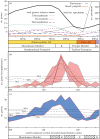When and how did the terrestrial mid-Permian mass extinction occur? Evidence from the tetrapod record of the Karoo Basin, South Africa
- PMID: 26156768
- PMCID: PMC4528552
- DOI: 10.1098/rspb.2015.0834
When and how did the terrestrial mid-Permian mass extinction occur? Evidence from the tetrapod record of the Karoo Basin, South Africa
Abstract
A mid-Permian (Guadalupian epoch) extinction event at approximately 260 Ma has been mooted for two decades. This is based primarily on invertebrate biostratigraphy of Guadalupian-Lopingian marine carbonate platforms in southern China, which are temporally constrained by correlation to the associated Emeishan Large Igneous Province (LIP). Despite attempts to identify a similar biodiversity crisis in the terrestrial realm, the low resolution of mid-Permian tetrapod biostratigraphy and a lack of robust geochronological constraints have until now hampered both the correlation and quantification of terrestrial extinctions. Here we present an extensive compilation of tetrapod-stratigraphic data analysed by the constrained optimization (CONOP) algorithm that reveals a significant extinction event among tetrapods within the lower Beaufort Group of the Karoo Basin, South Africa, in the latest Capitanian. Our fossil dataset reveals a 74-80% loss of generic richness between the upper Tapinocephalus Assemblage Zone (AZ) and the mid-Pristerognathus AZ that is temporally constrained by a U-Pb zircon date (CA-TIMS method) of 260.259 ± 0.081 Ma from a tuff near the top of the Tapinocephalus AZ. This strengthens the biochronology of the Permian Beaufort Group and supports the existence of a mid-Permian mass extinction event on land near the end of the Guadalupian. Our results permit a temporal association between the extinction of dinocephalian therapsids and the LIP volcanism at Emeishan, as well as the marine end-Guadalupian extinctions.
Keywords: Guadalupian; Karoo; Permian; U–Pb geochronology; biostratigraphy; tetrapod extinction.
© 2015 The Author(s) Published by the Royal Society. All rights reserved.
Figures




Similar articles
-
The base of the Lystrosaurus Assemblage Zone, Karoo Basin, predates the end-Permian marine extinction.Nat Commun. 2020 Mar 18;11(1):1428. doi: 10.1038/s41467-020-15243-7. Nat Commun. 2020. PMID: 32188857 Free PMC article.
-
Evidence from South Africa for a protracted end-Permian extinction on land.Proc Natl Acad Sci U S A. 2021 Apr 27;118(17):e2017045118. doi: 10.1073/pnas.2017045118. Proc Natl Acad Sci U S A. 2021. PMID: 33875588 Free PMC article.
-
Ecological dynamics of terrestrial and freshwater ecosystems across three mid-Phanerozoic mass extinctions from northwest China.Proc Biol Sci. 2021 Mar 31;288(1947):20210148. doi: 10.1098/rspb.2021.0148. Epub 2021 Mar 17. Proc Biol Sci. 2021. PMID: 33726593 Free PMC article.
-
Permian-Triassic Osteichthyes (bony fishes): diversity dynamics and body size evolution.Biol Rev Camb Philos Soc. 2016 Feb;91(1):106-47. doi: 10.1111/brv.12161. Epub 2014 Nov 27. Biol Rev Camb Philos Soc. 2016. PMID: 25431138 Review.
-
Rapid turnover of top predators in African terrestrial faunas around the Permian-Triassic mass extinction.Curr Biol. 2023 Jun 5;33(11):2283-2290.e3. doi: 10.1016/j.cub.2023.04.007. Epub 2023 May 22. Curr Biol. 2023. PMID: 37220743 Review.
Cited by
-
A new therocephalian (Gorynychus masyutinae gen. et sp. nov.) from the Permian Kotelnich locality, Kirov Region, Russia.PeerJ. 2018 Jun 8;6:e4933. doi: 10.7717/peerj.4933. eCollection 2018. PeerJ. 2018. PMID: 29900076 Free PMC article.
-
Distributions of extinction times from fossil ages and tree topologies: the example of mid-Permian synapsid extinctions.PeerJ. 2021 Dec 9;9:e12577. doi: 10.7717/peerj.12577. eCollection 2021. PeerJ. 2021. PMID: 34966586 Free PMC article.
-
Gigantism and Its Implications for the History of Life.PLoS One. 2016 Jan 15;11(1):e0146092. doi: 10.1371/journal.pone.0146092. eCollection 2016. PLoS One. 2016. PMID: 26771527 Free PMC article.
-
Effects of taphonomic deformation on geometric morphometric analysis of fossils: a study using the dicynodont Diictodon feliceps (Therapsida, Anomodontia).PeerJ. 2020 Oct 7;8:e9925. doi: 10.7717/peerj.9925. eCollection 2020. PeerJ. 2020. PMID: 33083110 Free PMC article.
-
Morphological evolution in therocephalians breaks the hypercarnivore ratchet.Proc Biol Sci. 2019 Apr 10;286(1900):20190590. doi: 10.1098/rspb.2019.0590. Proc Biol Sci. 2019. PMID: 30966993 Free PMC article.
References
-
- Jin YG. 1993. The pre-Lopingian benthos crisis. C. R. XII ICCP Buenos Aires 2, 269–278.
-
- Sepkoski JJ., Jr 1996. Patterns of Phanerozoic extinction: a perspective from global databases. In Global events and event stratigraphy in the Phanerozoic (ed. Walliser OH.), pp. 35–51. Berlin, Germany: Springer.
-
- Wang XD, Sugiyama T. 2000. Diversity and extinction patterns of Permian coral faunas of China. Lethaia 33, 285–294. (10.1080/002411600750053853) - DOI
-
- Ota A, Isozaki Y. 2006. Fusuline biotic turnover across the Guadalupian-Lopingian (Middle-Upper Permian) boundary in mid-oceanic carbonate buildups: biostratigraphy of accreted limestone in Japan. J. Asian Earth Sci. 26, 353–368. (10.1016/j.jseaes.2005.04.001) - DOI
Publication types
MeSH terms
LinkOut - more resources
Full Text Sources
Other Literature Sources

